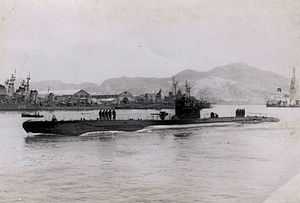Spanish submarine G-7
 S-01 in Cartagena, Spain | |
| Career (Nazi Germany) | |
|---|---|
| Name: | U-573 |
| Ordered: | 24 October 1939 |
| Builder: | Blohm & Voss of Hamburg |
| Laid down: | 8 June 1940 |
| Launched: | 17 April 1941 |
| Commissioned: | 5 June 1941 |
| Decommissioned: | 2 August 1942 |
| Fate: | Damaged by aircraft and interned at Cartagena on 2 May 1942. Sold to Spain on 2 August 1942.[1] |
| Career (Spain) | |
| Name: | G-7 |
| Acquired: | 1942 |
| Commissioned: | 2 August 1942 |
| Decommissioned: | 2 May 1970 |
| Renamed: | S-01 (1961) |
| Struck: | 1970 |
| Fate: | Broken up |
| General characteristics | |
| Type: | Type VIIC submarine |
| Displacement: |
769 tonnes (757 long tons) surfaced 871 t (857 long tons) submerged |
| Length: |
67.1 m (220 ft 2 in) o/a 50.5 m (165 ft 8 in) pressure hull |
| Beam: |
6.2 m (20 ft 4 in) o/a 4.7 m (15 ft 5 in) pressure hull |
| Draft: | 4.74 m (15 ft 7 in) |
| Propulsion: |
2 × supercharged Germaniawerft 6-cylinder 4-stroke M6V 40/46 diesel engines, totalling 2,800–3,200 bhp (2,100–2,400 kW). Max rpm: 470-490 2 × electric motors, totalling 750 shp (560 kW) and max rpm: 296 |
| Speed: |
17.7 knots (20.4 mph; 32.8 km/h) surfaced 7.6 knots (8.7 mph; 14.1 km/h) submerged |
| Range: |
15,170 km (8,190 nmi) at 10 kn (19 km/h) surfaced 150 km (81 nmi) at 4 kn (7.4 km/h) submerged |
| Test depth: |
230 m (750 ft) Crush depth: 250–295 m (820–968 ft) |
| Complement: | 44–52 officers and ratings |
| Armament: |
• 5 × 533 mm (21 in) torpedo tubes (four bow, one stern) • 14 × torpedoes or 26 TMA mines • 1 × C35 88mm gun/L45 deck gun (220 rounds) • Various AA guns |
Spanish submarine G-7 was a submarine of the Spanish Navy from 1942 to 1970. She was originally the U-573, a Type VIIC submarine of the German Kriegsmarine.
Acquisition
On May 2, 1942, U-573 limped into Cartagena harbor, badly damaged after being attacked with two depth charges by an RAF Lockheed Hudson bomber. Realizing that repair was impractical, the Kriegsmarine sold the boat to Spain for 1.5 million Reichsmark. The Spanish Navy was obviously interested on the submarine as at the time was trying to locally produce six Type VIIC-class submarines, designated G Class, being unable to meet the target due to technical reasons. On August 2, she was commissioned into the Spanish Navy as G-7.
Service history
Work started in August 1943 but took four years to complete. The damage caused by the British attack was found to be more extensive than was first thought; also German technical assistance and parts were difficult to obtain in the last years of World War II and after. In addition, Spain’s economy was weak following the Spanish Civil War. Repairs were completed in early 1947 and on 5 November 1947 G-7 was re-commissioned. The bow's net cutter and the 20mm antiaircraft cannon were removed.
Despite the Type VII being out-dated by the end of World War II, G-7 was the most modern of Spain’s submarine fleet; her other vessels (two ex-Italian, and four home-built boats) dating from the early 1930s. G-7 lacked radar and did not possess a Schnorkel. In 1951 development was started on a schnorkel design by Empresa Nacional Bazán, the Spanish shipbuilding company, but these came to nothing when the Spanish Navy bought the former US Navy submarine USS Kraken.
In 1958, as one of the few U-boats still in existence, G-7 was used in the German war film U 47 – Kapitänleutnant Prien about Gunther Prien and his U-47.
In 1961 the Spanish Navy’s submarine force was re-numbered, and G-7 became S-01.
On 2 May 1970 she was de-commissioned after 23 years service. She was auctioned for 3,334,751 Pts (about $26,500), after which, despite efforts to save and preserve her as a museum, the submarine was broken up for scrap.
Notes
- ↑ Kemp, Paul: U-Boats Destroyed - German Submarine Losses in the World Wars, 1997, Arms & Armour, ISBN 1-85409-515-3, p. 81.
External links
- G-7 (U-573) at mundohistoria.org (Spanish)
- G-7 at perso.wanadoo.es (Spanish)